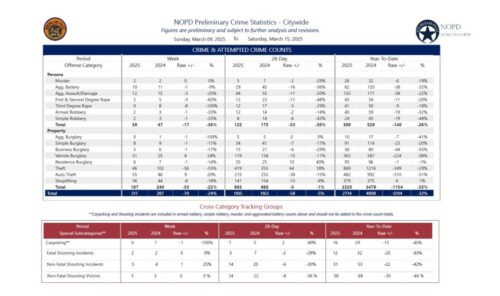New Orleans Crime Rates in 2025: What the Numbers Really Say
New Orleans has long been a city of vibrant culture, rich history, and undeniable charm. Yet, it has also faced persistent challenges with crime, which often dominate headlines and shape public perception. As we move through 2025, it’s essential to look beyond the surface and understand what the latest crime statistics truly reveal about the city’s safety landscape. This article delves into the most recent data, explores trends, and offers context to help residents, visitors, and policymakers grasp the real story behind New Orleans’ crime rates.
Understanding the Crime Landscape in New Orleans
New Orleans has consistently ranked among cities with higher crime rates in the United States, but these numbers don’t tell the whole story. Crime is a multifaceted issue influenced by economic, social, and political factors. In 2025, the city continues to grapple with challenges such as poverty, unemployment, and systemic inequalities, which contribute to certain types of criminal activity.
However, it’s important to differentiate between various categories of crime. Violent crimes, property crimes, and drug-related offenses each have different implications for public safety and community well-being. By examining these categories separately, a clearer picture emerges of where improvements have been made and where attention is still needed.
Violent Crime Trends in 2025
In a historic turnaround, violent crime in New Orleans has dropped significantly in 2025 homicides are down by over 25% in the first half of the year, placing the city on track to
have its lowest murder rate in nearly 50 years. These figures encompass all categories, including different degrees of murder—from first-degree premeditated cases to lesser charges such as second-degree or manslaughter. The decline reflects the impact of targeted policing, early intervention, and stronger ties between law enforcement and local communities. This progress is credited to a combination of community-based policing, targeted patrols, and expanded social service partnerships aimed at addressing root causes of violence. Aggravated assaults and armed robberies have both declined substantially in 2025. City officials attribute this to data-driven policing, hotspot targeting, and increased cooperation with community groups. Despite this progress, violent crime remains a significant concern.
Property Crime: A Mixed Picture
Property crimes, including burglary, theft, and motor vehicle theft, represent a substantial portion of New Orleans’ overall crime statistics. Contrary to previous years, 2025 has brought a sharp decline in property crimes across New Orleans. Motor vehicle thefts have fallen by over 30%, and burglaries and thefts are also down. This decline reflects the effectiveness of expanded neighborhood patrols, better surveillance technology, and increased public cooperation. On the other hand, residential burglaries have declined slightly, reflecting improved neighborhood watch programs and advances in home security technology. These shifts suggest that while some property crimes are on the rise, community engagement and
preventative measures are making a difference in other areas.
Factors Influencing Crime Rates in New Orleans
To understand why certain crime rates fluctuate, it’s crucial to consider the broader social and economic context. New Orleans faces persistent challenges that impact crime, including economic inequality, education disparities, and housing instability. These factors create environments where crime can thrive, especially in under-served communities. Moreover, the city’s unique geography and tourism-driven economy influence crime dynamics. Tourist hotspots often experience different crime patterns compared to residential neighborhoods, with petty theft and scams more common in areas frequented by visitors. Law enforcement agencies have adapted by increasing patrols and surveillance in these zones, aiming to protect both residents and tourists.
The Role of Policing and Community Initiatives
Policing strategies in New Orleans have evolved significantly over recent years. The NOPD has prioritized community policing, emphasizing relationship-building and proactive engagement rather than reactive enforcement. These efforts have shown promise in reducing violent incidents and fostering trust between law enforcement and residents. Additionally, community organizations play a vital role in crime prevention. Programs focused on youth mentorship, job training, and mental health support contribute to addressing root causes of criminal behavior. In 2025, partnerships between the city government, nonprofits, and local businesses have expanded, reflecting a collaborative approach to public safety.
What the Numbers Mean for Residents and Visitors
For residents, understanding the nuances behind crime statistics is essential for making informed decisions about safety and community involvement. While some areas of New Orleans continue to face challenges, many neighborhoods have experienced improvements in security and quality of life. Staying informed about local crime trends and participating in neighborhood watch or community meetings can empower residents to contribute to safer environments. Visitors to New Orleans should remain aware but not alarmed. Like any major city, New Orleans has areas that warrant caution, especially after dark. However, the city’s vibrant culture, music scene, and culinary delights remain accessible and enjoyable with standard travel precautions. Tourist districts benefit from heightened security measures, and many crimes reported in these areas tend to be non-violent and opportunistic.
Conclusion: Interpreting the 2025 Crime Data with Context
The data from 2025 reveals a remarkable and historic drop in both violent and property crimes in New Orleans. The city is no longer following national trends but leading them in terms of urban crime reduction. These gains are the result of targeted policing, community programs, and renewed civic trust. While challenges remain, especially in rebuilding long-term public safety infrastructure, the 2025 crime statistics tell a story of progress, not
decline. Understanding these numbers in context helps dispel myths and encourages a more balanced view of the city’s safety. New Orleans continues to be a city of resilience and renewal. By combining data-driven strategies with community empowerment, it is possible to create a safer environment for all
who live in and visit the Crescent City. Staying informed and engaged remains key to supporting these ongoing efforts and appreciating the true story behind the crime statistics.










Nice breakdown — helpful context. Quick question: do the 2025 reductions in violent crime vary much by neighborhood, or is the drop citywide? Also, any reliable public source where I can see the raw monthly figures?
I think NOPD has the facts. The crime map can be really helpful https://communitycrimemap.com/?address=New%20Orleans,LA&startDate=30&endDate=0